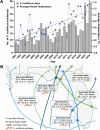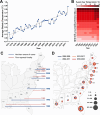Climate change and Vibrio vulnificus dynamics: A blueprint for infectious diseases
- PMID: 39680617
- PMCID: PMC11649097
- DOI: 10.1371/journal.ppat.1012767
Climate change and Vibrio vulnificus dynamics: A blueprint for infectious diseases
Abstract
Climate change is having increasingly profound effects on human health, notably those associated with the occurrence, distribution, and transmission of infectious diseases. The number of disparate ecological parameters and pathogens affected by climate change are vast and expansive. Disentangling the complex relationship between these variables is critical for the development of effective countermeasures against its effects. The pathogen Vibrio vulnificus, a naturally occurring aquatic bacterium that causes fulminant septicemia, represents a quintessential climate-sensitive organism. In this review, we use V. vulnificus as a model organism to elucidate the intricate network of interactions between climatic factors and pathogens, with the objective of identifying common patterns by which climate change is affecting their disease burden. Recent findings indicate that in regions native to V. vulnificus or related pathogens, climate-driven natural disasters are the chief contributors to their disease outbreaks. Concurrently, climate change is increasing the environmental suitability of areas non-endemic to their diseases, promoting a surge in their natural populations and transmission dynamics, thus elevating the risk of new outbreaks. We highlight potential risk factors and climatic drivers aggravating the threat of V. vulnificus transmission under both scenarios and propose potential measures for mitigating its impact. By defining the mechanisms by which climate change influences V. vulnificus disease burden, we aim to shed light on the transmission dynamics of related disease-causing agents, thereby laying the groundwork for early warning systems and broadly applicable control measures.
Copyright: © 2024 Jayakumar et al. This is an open access article distributed under the terms of the Creative Commons Attribution License, which permits unrestricted use, distribution, and reproduction in any medium, provided the original author and source are credited.
Conflict of interest statement
The authors have declared that no competing interests exist.
Figures



References
-
- COP26 Special Report on Climate Change and Health: the Health Argument for Climate Action [Internet]. 2021. Available from: https://www.who.int/publications/i/item/9789240036727.
-
- Romanello M, Napoli CD, Green C, Kennard H, Lampard P, Scamman D, et al.. The 2023 report of the Lancet Countdown on health and climate change: the imperative for a health-centred response in a world facing irreversible harms. Lancet. 2023;402(10419):2346–94. doi: 10.1016/S0140-6736(23)01859-7 - DOI - PMC - PubMed
Publication types
MeSH terms
LinkOut - more resources
Full Text Sources
Medical

